
HMS Battleaxe was a Weapon-class destroyer of the Royal Navy, completed just after the Second World War.

HMS Lowestoft was a Rothesay-class or Type 12 class anti-submarine frigate of the British Royal Navy. Lowestoft was reconstructed in the late 1960s to largely the same pattern as the third group of Leander-class frigates, with new radar and fire control and a hangar and pad for a Westland Wasp helicopter for longer range, anti-submarine, engagement. In the late 1970s it was converted as the prototype towed array frigate for the Royal Navy, but retained its full armament. Lowestoft was sunk as a target on 8 June 1986 by HMS Conqueror using a Tigerfish torpedo. She was the last Royal Naval target to be sunk still displaying her pennant number.

The Commandant Rivière class was a class of frigates built for the French Navy in the late 1950s and early 1960s. Labeled "aviso-escorteur", they were designed to perform the role of overseas patrol in peacetime and anti-submarine escort in wartime. This vessel class is named after the French Navy officer Henri Rivière (1827–1883).

HMS Mermaid was a Modified Black Swan-class sloop of the Royal Navy. Mermaid saw service as a convoy escort during the Second World War, taking part in the sinking of two German submarines while escorting Arctic convoys to and from the Soviet Union.

The Le Normand class was a class of 14 fast frigates built for the French Navy in the late 1950s. They were an immediate follow-on from the earlier Le Corse-class frigates, and like them, were long-range convoy escorts capable of high speed. The first seven ships, paid for by the United States under the Mutual Defense Assistance Act were ordered in 1952. The remaining seven ships were paid for by France and ordered between 1953 and 1955.

The Mendoza class were a series of three destroyers built in the United Kingdom for the Argentine Navy in the 1920s. They were the first part of the Argentine re-armament programme of the 1920s. Construction began in 1927 and all three were commissioned in 1929. All three destroyers were converted to anti-aircraft escorts in 1958 and remained in service until 1962 when they were discarded.

NRP Gonçalo Velho was a 2nd class sloop of the Portuguese Navy. She was designed to operate in the overseas territories of Portugal.
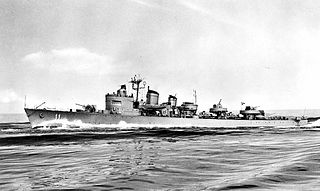
The Visby class was a Swedish World War II destroyer class. During the years 1942–1944 four ships, Visby, Sundsvall, Hälsingborg and Kalmar, were built and delivered to the Swedish navy. The ships were a part of Sweden's military buildup during the war. Under this period the ships were used as neutral guards and escort ships. In 1965 the ships were modified and rebuilt as frigates. Two of the ships were decommissioned in 1978 and the last two followed in 1982.

The Bergamini class was a class of four frigates operated by the Italian Navy. They entered service in 1961, with the last one being stricken in 1988.

The Najaden class, also known as the Huitfeldt class, was a class of two torpedo boats built for and operated by the Royal Danish Navy. Construction started in 1942, with the ships being completed in 1947, and continuing in service until 1966.
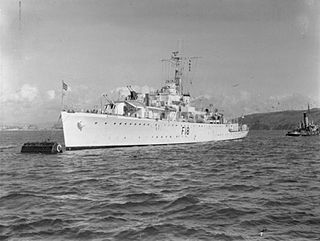
HMS Flamingo was a Black Swan-class sloop of the Royal Navy. She saw service as a convoy escort during the Second World War, seeing extensive service in the Mediterranean and Far East in 1945.

HMS Hart was a modified Black Swan-class sloop of the Royal Navy. She saw service as a convoy escort during the Second World War, seeing service in the Atlantic, Mediterranean and Far East in 1945. She also took part in the Korean War in 1950 and 1951.
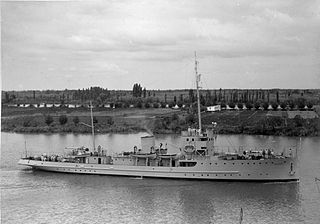
The Bouchard-class minesweepers were a class of nine minesweepers, designed and built in Argentina, in service with the Argentine Navy from 1937 to the late 1960s. One of the class was lost after running aground in the Straits of Magellan and the remaining eight were discarded. Three were transferred to the Paraguayan Navy and remained in service as of late 1990s. In Paraguayan service, they were used for river patrol work. One of the class was docked in Asunción, Peru in 2009 with the intention of converting the vessel to a museum ship
INS Brahmaputra was a Leopard-class frigate of the Indian Navy. She was built by the Scottish shipbuilder John Brown & Company and completed in March 1958. Brahmaputra served during the Indo-Pakistani War of 1965 and the Indo-Pakistani War of 1971. She was scrapped in 1986.

The Audaz class was a class of nine destroyers built for the Spanish Navy after the Second World War. Construction was slow, with only four completed to the original design from 1953–1956. The remaining five ships completed as anti-submarine escorts with a new armament and sensor fit from 1960 to 1965, while the original four ships were also modified to this standard. Built at Ferrol, they completed in 1946–1950 and were rated as gunboats, and were redesignated as frigates in 1959. The last of the class, Intrepido, was stricken in 1982.
The Pizzaro class was a class of eight escort vessels built for the Spanish Navy in the 1940s. Built at Ferrol, they were completed in 1946–1950 rated as gunboats, and were redesignated as frigates in 1959. They started to be withdrawn from use in 1968, with the last of the class, Vincente Yañez Pinzon, stricken in 1982.
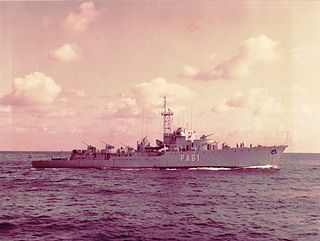
The Atrevida class was a class of six corvettes built for the Spanish Navy in the 1950s.
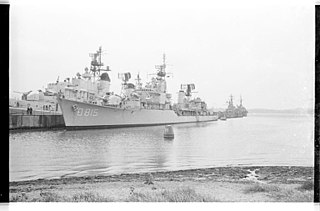
HNLMS Overijssel (D815) was a destroyer of the Friesland class. The ship was in service with the Royal Netherlands Navy from 1957 to 1982. The destroyer was named after the Dutch province of Overijssel and was the twelfth ship with this name. In 1982 the ship was taken out of service and sold to Peru where it was renamed Coronel Bolognesi.
Audaz was a Spanish destroyer of the class of the same name that was built after the Second World War. Audaz was lauched in 1951 and completed in 1953. The ship was modified to an anti-submarine escort in the 1960s, and was stricken in 1974.
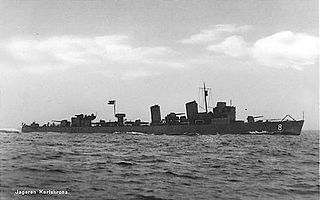
HSwMS Karlskrona was a destroyer of the Royal Swedish Navy that served during the Second World War and in the Cold War. The fourth member of the Göteborg or city class, which was designed as an improvement on the previous Ehrensköld class, Karlskrona was launched on 16 June 1939. The destroyer served in the Coastal Fleet during the war, protecting Swedish neutrality and escorting convoys. After the war, the ship was upgraded between 1950 and 1951 with enhanced fire control and an armament improved with the introduction of the Bofors 40 mm anti-aircraft gun. Ten years later, in 1961, Karlskrona was designated a fast anti-submarine frigate and the torpedo tubes were replaced by Squid mortars. The vessel was decommissioned on 1 July 1974 and broken up in 1979.
















